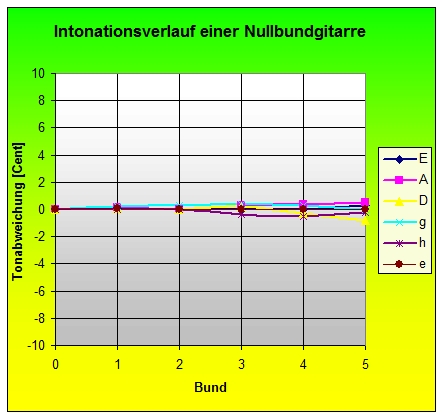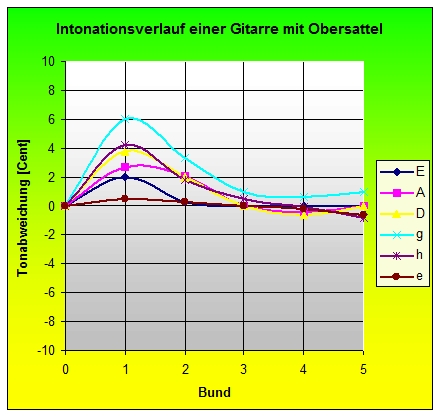Zero fret

As a zero fret (English Zero Fret ), the frets before the 1st fret, just behind the saddle , on the fingerboard of stringed instruments called.
The strings of an instrument equipped with a zero fret always rest on this fret , which means that unhandled strings (“open strings”) sound just like those that are fingered. Occasionally, thicker fret wire is chosen for the zero fret compared to the rest of the fret. This happens because the zero fret has to form the highest point of contact of the strings on the fingerboard, so that the strings do not cause any unwelcome background noises due to being too low ("snarling") when played. The saddle immediately in front of the zero fret therefore only has the task of determining the distance between the individual strings.
A zero fret has several advantages: The height of the other frets of the instrument can be more easily adjusted when they are installed ("fret"). There is no need to adjust the depth of the saddle notches, as the zero fret determines the height of the string position. In addition, compared to bone and plastic saddles, a metal zero fret is less prone to wear and tear from the friction of the strings.
Guitarist whose playing style on strong string bending ( string-bending ) is aligned, but feel a zero fret often distracting, because the strings out by lateral displacement only in the leadership of the saddle notches limitation. When pulling, the strings also slide over the zero fret in front of it, which on the one hand makes bending somewhat difficult and on the other hand occasionally leaves individual strings outside their original position.
The zero fret first appeared in instrument making in the 1920s and is considered a European, if not a German innovation. An indication of this is given by the Anglo-American usage, in which the zero fret is also referred to as German fret (" German fret "). In fact, the zero fret can be found on many steel-stringed instruments made in Europe, including the fingerboards of the legendary Maccaferri guitars.
Real and increased zero fret
A true zero fret is when the height of the last fret in continuation of the fingerboard is the same as that of the previous frets. A fake zero fret has a higher fret and thus a higher string position, which leads to the same intonation problems as with the more common upper saddle.
Guitar intonation in first position
Intonation is understood to mean the exact adherence to the pitch of the equally tempered tuning, or the deviation of the pitch of a note played from the specified target value. The raising of the strings by the top nut or the false zero fret causes the string tension to be greater on the first and second frets when pressed down than on the following frets. The higher the string position, the clearer the detuning of the fingered notes becomes. The G string with the G sharp on the first fret and thus the E major chord in the first position is most affected. Due to the equal tempering, the third is already higher than in the natural triad and due to the additional increase due to the string tension on the first fret, the tone is even more detuned. If the strings at the end of the fingerboard are too high, the first and second positions are almost unplayable on many guitars. Deviations in the G sharp at the first fret of +10 cents are not uncommon, especially with steel strings.
A very low string position on the upper saddle or zero fret improves the intonation and playability, but the risk of string clinking increases. To compensate, the string position on the bridge must be increased. A curved fingerboard has not been common in classical guitar making. Only the concert zither knows such a fingerboard with corresponding corrections of the fret spacing in order to achieve the exact intonation despite the fretboard curvature. In addition, the curvature of the entire neck of electric guitars can be adjusted more or less well.
literature
- Franz Jahnel: The guitar and its construction - technology of guitar, lute, mandolin, sister, tanbur and strings. Verlag Erwin Bochinsky, Frankfurt am Main 1963. (7th edition. 1999, ISBN 3-923639-09-0 )
- Eberhard Meinel (Ed.): Intonation, tempering, scale compensation for plucked instruments. West Saxon University, Zwickau 2006, ISBN 3-00-018587-9 .



